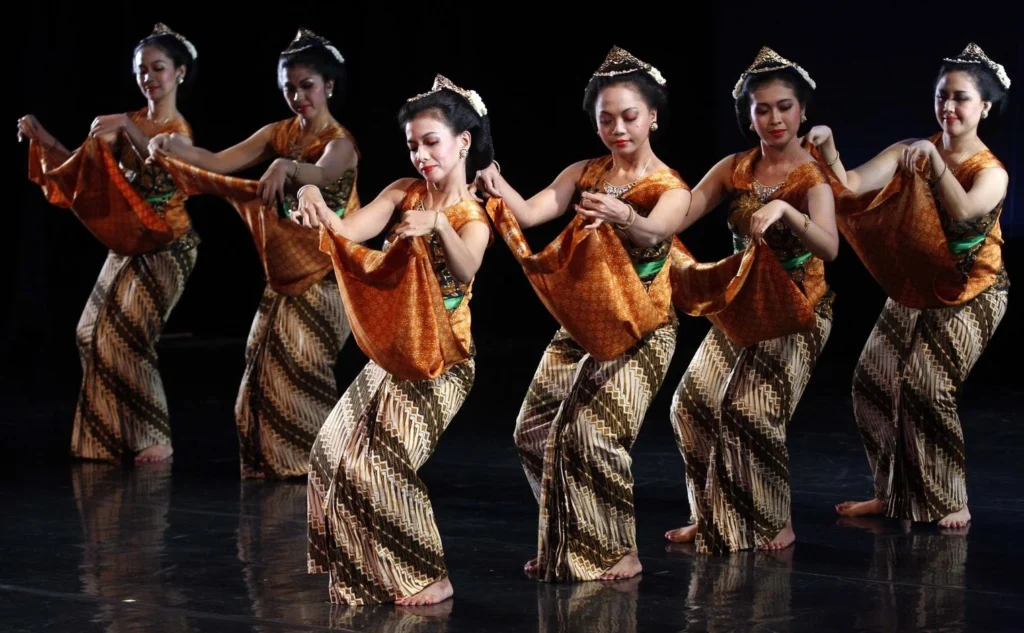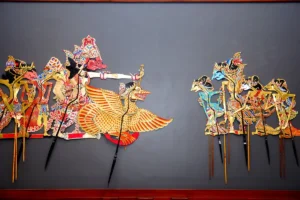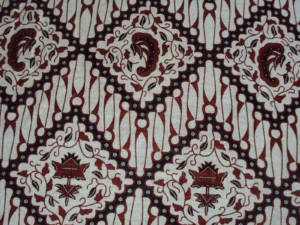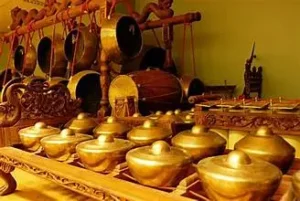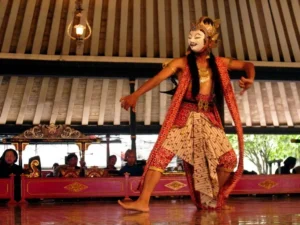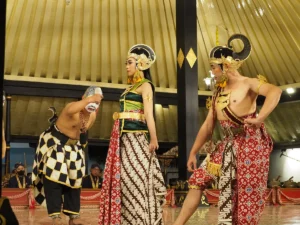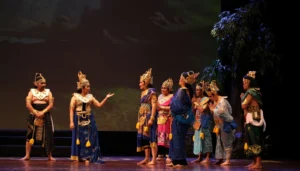Yogyakarta, often referred to as the city of art and culture in Indonesia, is home to several forms of traditional arts rich in cultural and historical values. With its abundant diversity, the traditional arts of Yogyakarta enrich Indonesia’s cultural heritage and continue to be a draw for both domestic and foreign tourists. In this article, we will explore eight traditional arts of Yogyakarta that enrich the cultural wealth of Indonesia, still thriving and evolving on the island of Java, particularly in Yogyakarta.
One of the most famous traditional arts is “Wayang Kulit.” Wayang Kulit performances are a cultural heritage that has existed since the time of the Mataram Kingdom. In Yogyakarta, Wayang Kulit performances are not only entertainment but also a means of conveying moral and historical messages to the audience.
Not to forget, “Gamelan” is also a hallmark of Traditional Arts of Yogyakarta. The unique musical harmonies of Gamelan often accompany various artistic performances in Yogyakarta, adding a magical and traditional touch to each event. With its artistic diversity, Yogyakarta continues to exude cultural charm, becoming a must-visit destination for enthusiasts of Indonesian traditional arts and cultures.
The 8 Traditional Arts of Yogyakarta
1.Wayang Kulit
source: indonesia.travel
Wayang kulit is one of Traditional Arts of Yogyakarta deeply rooted since the era of kingdoms in Indonesia. Amidst the bustling city of Yogyakarta, the presence of wayang kulit is still highly revered and often an integral part of various customary events, ceremonies, and regular performances. Wayang kulit performances can last throughout the night, demonstrating the intelligence and creativity of the actors as well as the power of the accompanying gamelan. This Yogyakarta traditional art not only offers entertainment but also contains profound meanings that deepen the belief and popular Javanese tales.
Young generations are also encouraged to draw lessons and teachings from each wayang kulit performance they attend. The experience of watching wayang kulit in Yogyakarta is a captivating and profound one that enriches the knowledge of Indonesian history and culture. With its perpetuation, wayang kulit becomes a cultural heritage to be preserved and safeguarded to maintain the identity and richness of Traditional Arts of Yogyakarta, rich in art and local wisdom.
2.Batik
source: indonesian-originalbatik-shop.blogspot.com
Batik is one of the many intangible cultural heritages of Indonesia that has captured the world’s attention. Yogyakarta, in this context, plays a significant role as one of the leading centers of renowned traditional batik production. Here, the batik-making process is still carried out using traditional methods involving canting and wax as primary tools. Each step of this process is not only a craftsmanship but also a heritage passed down through generations. The characteristic batik patterns of Yogyakarta have captivating beauty and diversity.
From classic patterns laden with philosophical meanings to modern patterns following the evolution of time, each batik artwork brings its own narrative and beauty. The complex and detailed batik-making process is evidence of artisans’ perseverance in preserving this cultural tradition. The batik-making process is not only a finished product but also an integral part of Yogyakarta’s cultural heritage. The teaching of batik-making techniques is also passed down from generation to generation.
Tourists visiting Yogyakarta have the opportunity to directly see the batik-making process in various batik galleries, or even participate in workshops to learn how to make batik themselves. Owning an authentic batik from Yogyakarta is not just having a piece of clothing but also a symbol of pride for Indonesia’s cultural richness. Each motif and color on batik has its own meaning, reflecting local wisdom as well as the beauty of Indonesian nature and culture.
By wearing authentic batik from Yogyakarta, one also indirectly participates in promoting and preserving Traditional Arts of Yogyakarta. Therefore, the appreciation of batik is not only as clothing but also as a cultural heritage to be preserved for the perpetuation of Indonesia’s cultural richness. By maintaining and supporting the production and use of batik, we contribute to preserving a rich and valuable cultural identity for current and future generations.
3.Traditional Dance
source: daftarwisatajogja.blogspot.com
Yogyakarta, a city rich in cultural heritage, is known not only for its beautiful nature but also for its rich and captivating art. A remarkable aspect of traditional art is its amazing traditional dances. Traditional Arts of Yogyakarta have become an integrated element of Javanese society’s cultural life, continuously preserved and appreciated to this day.
Dances such as Bedhaya Dance, Serimpi Dance, and Golek Dance are excellent examples of Yogyakarta’s traditional dance arts heritage. Every graceful movement and every sumptuous costume gives a captivating glimpse of Javanese culture’s elegance. Traditional dance performances in Yogyakarta are not only visually stimulating but also convey deep philosophical messages.
Legendary tales and values of Javanese society’s life are often expressed through fluid movements in these dance performances. The presence of traditional dances in Yogyakarta is not only entertainment but also a means of preserving a rich cultural identity. Through these traditional dances, the young are encouraged to appreciate and understand their rich cultural roots. This makes Traditional Arts of Yogyakarta so important in Indonesia’s cultural landscape.
Furthermore, Traditional Arts of Yogyakarta are also a major attraction for tourists visiting the city. They can not only enjoy the beauty of nature but also feel the cultural richness offered by the city through impressive traditional dance performances. This also contributes to local economic growth by stimulating tourists’ interest in visiting Yogyakarta.
Traditional dance in Yogyakarta has become an integral part of the city’s cultural identity. Through its preservation and development efforts, it is hoped that this traditional art will continue to inspire and awe present and future generations. Thus, Yogyakarta will remain a fascinating and proud cultural center, with its traditional dances continuing to radiate the beauty and elegance of Javanese cultural heritage.
Read also: 11 Amazing Traditional Dances of Yogyakarta
4.Gamelan
source: latitudes.nu
Gamelan, as a Javanese traditional music ensemble, has carved its own history in its existence in Yogyakarta. Comprising various instruments such as gongs, kendang, saron, and slenthem, gamelan is not only a part of Javanese cultural heritage but also the soul of Traditional Arts of Yogyakarta. Amidst the bustling of Traditional Arts of Yogyakarta, gamelan stands out as an indispensable element in every performance.
Whether accompanying dance, wayang kulit, or even solo music, the presence of gamelan always brings a distinctive color and depth of soul. The sounds of shimmering gongs, striking drums, gentle saron harmonies, and undulating slenthem melodies blend into captivating harmony. Gamelan is not limited to artistic performances; it has also permeated the daily lives of Yogyakarta residents. Strong cultural identity for the Javanese is reflected in the presence of gamelan. The distinctive sounds and rhythms have become features distinguishing Traditional Arts of Yogyakarta from other regions.
For tourists visiting Yogyakarta, the experience of enjoying a live gamelan performance is a must. They can directly feel the vibrations and power transmitted by each gamelan instrument. Through enchanting music, tourists can feel the warmth and beauty of Javanese culture deeply rooted in this city. However, gamelan also offers music enthusiasts the opportunity to learn and master the art of playing these instruments.
In Yogyakarta, there are several courses and workshops available for those who wish to learn gamelan directly. This not only enriches tourists’ experience but also contributes to the preservation of Traditional Arts of Yogyakarta. Thus, gamelan is not only a traditional music ensemble but also a symbol of Javanese cultural strength and diversity that continues to live and develop in Yogyakarta. Through the beauty of sounds and rhythms, gamelan has become one of the most precious cultural heritages for Yogyakarta residents and attracts tourists who want to experience the cultural magic offered by this city.
5.Traditional Mask (Topeng Tradisional)
source: pinterest.com
Traditional mask (topeng tradisional) plays an important role in Traditional Arts of Yogyakarta panorama. It is considered not only as mere entertainment, but these masks carry a much deeper meaning, encompassing spiritual and magical aspects that are integral to Javanese society’s life. At each performance, traditional mask not only entertains but also conveys rich moral and spiritual messages. Mythological stories are often the main theme of traditional mask performances.
From tales of Ramayana to those of Mahabharata, each mask representation takes the audience on a fascinating journey through the Javanese mythological world, rich in epic stories. On the other hand, traditional mask also often addresses moral values cherished by the local community. Through the characters of the performances, audiences are invited to reflect on the hidden meanings of daily life. Dramatic movements and impressive costumes are the distinctive features of traditional mask performances.
With each gesture imbued with expression, mask actors manage to bring characters of the stories they depict to life. The costumes worn are not merely clothing but also an integral part of the entire performance, enriching the visual experience of the audience. It’s no wonder that traditional mask performances are one of the main attractions for tourists visiting Yogyakarta. They can not only appreciate the beauty of the performances themselves but also feel the depth of the culture and spirituality they contain.
Through skillful magic and dramatization, traditional mask performances offer an unforgettable experience to each viewer. Thus, traditional mask is not just a form of performance art, but also a means of enriching the soul and weaving connections between the past and the present. Through captivating performances, traditional mask continues to play its role in preserving a cultural heritage rich in values and wisdom. As an inseparable component of Traditional Arts of Yogyakarta, traditional mask is one of the highlights of a fascinating and captivating cultural panorama.
6.Wayang Wong
source: genpijogja.com
Wayang wong, also known as wayang wong, is one of the grandest expressions of Traditional Arts of Yogyakarta. In its distinctive form, wayang wong presents epic narratives using human characters as the main protagonists. Wayang wong performances are often an indispensable element of customary ceremonies or special celebrations in Yogyakarta, making this art an integral part of the local community’s cultural life. The art of wayang wong requires extraordinary acting skills to portray the characters of the stories. Every movement, facial expression, and intonation of the voice are crucial elements that make wayang wong performances so captivating.
Furthermore, the use of magnificent costumes and detailed makeup also contributes to the charm of these performances. Through each of their performances, wayang wong not only entertains but also inspires and captivates audiences with the beauty and power of the stories they tell. In Yogyakarta, wayang wong is not just an art spectacle but also an element of rich and diverse cultural identity. This traditional art is one of the unique cultural riches of the city, a symbol of pride for the local population and attracting the interest of tourists from around the world to witness these spectacular performances.
Through wayang wong, audiences can feel the depth of the stories and the emotional power they contain. Wayang wong is not just entertainment but also carries deep philosophical and moral values. The narratives presented often contain relevant messages for daily life, as well as noble values cherished by Javanese society. Thus, wayang wong is not only an art spectacle but also a means of teaching and inspiring the new generation to appreciate and understand their cultural heritage.
In the overall panorama of Traditional Arts of Yogyakarta, wayang wong stands out as one of the highlights, radiating the beauty and power of Javanese culture. Through extraordinary performances, wayang wong continues to play its role in preserving and developing a cultural heritage so rich and precious. As an inseparable element of the cultural life of the Yogyakarta society, wayang wong remains a major attraction for those who want to experience the artistic and cultural magic offered by this city.
7.Traditional Arts
The traditional arts of Yogyakarta are reflected not only in the forms of performance but also in the beauty and expertise of the handicrafts produced by local artisans. In addition to batik, the characteristic emblem of Yogyakarta, various traditional crafts such as wood carving, bamboo weaving, and wayang kulit making are integral parts of the cultural wealth of this city. Local artisans in Yogyakarta have inherited skills passed down from generation to generation to create these traditional crafts. They not only respect the value of tradition but also develop their techniques and creativity to produce stunning works.
Each wood carving, each bamboo weaving, and each wayang kulit are made with care and dedication, reflecting the beauty and finesse of Javanese traditional art. The handicraft products of Yogyakarta have great aesthetic value, but also strong historical and cultural value. Through each beautiful wood carving, each elegant bamboo weaving, and each magnificent wayang kulit, the stories of the past and Javanese cultural values continue to live and develop. Local artisans not only create beautiful objects but also preserve and perpetuate a precious cultural heritage for the population of Yogyakarta.
For tourists visiting Yogyakarta, purchasing various handicraft products is not only a typical souvenir but also a way to support the preservation of local cultural heritage. By bringing home a beautiful wood carving, an elegant bamboo weaving, or a magnificent wayang kulit, tourists contribute to the preservation of Traditional Arts of Yogyakarta. Each of these handicraft products also becomes a precious memento of their visit, reminding them of the beauty of the art and culture they experienced during their stay in Yogyakarta.
Thus, the traditional arts of Yogyakarta are not only forms of art and beauty, but also guardians and heirs of rich cultural values. Through these handicrafts, cultural and historical values continue to live and develop, making them one of the most precious assets of Indonesia’s cultural landscape. Overall, the traditional arts of Yogyakarta can be seen in every detail of the crafted products, creating a close link between art, culture, and daily life.
8.Ketoprak
source: haloedukasi.com
The traditional arts of Yogyakarta are rich in culture, as evidenced by the various artistic expressions of its population. One of the typical arts deeply rooted in Javanese culture is Ketoprak. Ketoprak is a form of dramatic art that combines theater, music, and dance, with its own distinct characteristics in Yogyakarta.
Ketoprak tells epic and moral stories using the Javanese language. Ketoprak performances usually take place outdoors or in squares, accompanied by traditional Javanese music such as gamelan and gender. The stories presented in Ketoprak are often drawn from popular tales or legends widely known in society.
In Yogyakarta, Ketoprak is not only an artistic spectacle but also an integral part of the cultural life of the community. Ketoprak artists are not only skilled at acting roles and telling stories, but they also possess skills in various other aspects of traditional arts, such as dance, singing, and makeup. They have inherited this tradition from generation to generation, thus preserving the authenticity and cultural power of Traditional Arts of Yogyakarta.
Ketoprak performances also serve as an important platform for Islamic followers in Yogyakarta to spread moral and religious messages. In some performances, themes of Islam are often integrated into Ketoprak narratives, thus enriching the meanings and values conveyed to the audience. This shows how the Traditional Arts of Yogyakarta, such as Ketoprak, continue to evolve and adapt to the values and requirements of the time while maintaining their strong roots in local culture.
In addition to entertaining the population, Ketoprak also plays a crucial role in preserving local culture and identity. Through regular performances, younger generations can continue to be inspired and engaged with their cultural heritage. This contributes to maintaining the continuity of traditions and ensuring that the values conveyed by Traditional Arts of Yogyakarta remain relevant and appreciated by society.
Thus, Ketoprak is not only an artistic spectacle but also a symbol of cultural richness and identity for the population of Yogyakarta. Its continuity and ongoing evolution testify to the love and pride towards the cultural heritage of their ancestors. As a colorful and meaningful Traditional Arts of Yogyakarta, Ketoprak remains an indispensable element of local life and culture.
In conclusion
Yogyakarta, with its traditional artistic diversity, exerts an undeniable charm on tourists wishing to discover Indonesia’s cultural richness. The traditional arts of Yogyakarta, from wayang kulit to Javanese dances, offer a window into the beauty and richness of Indonesian cultural heritage. Through these various artistic expressions, Yogyakarta is not only an ordinary tourist destination but also a cultural center that preserves and revives ancestral traditions.
The traditional arts of Yogyakarta are not only tourist attractions but also essential tools for preserving a distinctive cultural identity. With each traditional artistic performance, local wisdom values are reflected and transmitted to future generations. The presence of Traditional Arts of Yogyakarta is not just nostalgia for the past but also a solid foundation for the continuity of a culture rooted in history.
With the Traditional Arts of Yogyakarta at the center of attention, Yogyakarta continues to enrich Indonesia’s cultural heritage and strengthen its position as a flagship destination. Tourists visiting this city are not only dazzled by its enchanting natural landscapes but also invited to feel the warmth and beauty of local culture through authentic traditional artistic performances.
Thus, the traditional arts of Yogyakarta are not only a tourist attraction but also a reflection of Indonesia’s cultural richness that deserves to be preserved and appreciated. Start planning your trip to Java now to witness firsthand the traditional arts of Yogyakarta with Hello Bali, we are ready to help and accompany you throughout your vacation on the island of Java. Contact us now!

